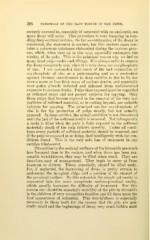Page 344 - My FlipBook
P. 344
206 PATHOLOGY OF THE HAED TISSUES OF THE TEETH.
securely covered in, especially if saturated with an antiseptic, no
more decay will occur. This procedure is very tempting in han-
dling deep occlusal cavities. So far as continuance of the decay is
concerned, the statement is correct, but this carious mass con-
tains a poisonous substance elaborated during the carious proc-
ess, which, when shut up in this way, especially endangers the
vitality of the pulp. This is the principal reason why we find so
many dead pulps under such fillings. It is always safer to remove
the decay completely and, when it is very deep, use oxyphosphate
of zinc. I am persuaded that much of the bad reputation of
oxyphosphate of zinc as a pulp-capping and as a protection
against thermal sensitiveness in deep cavities is due to its use
over a more or less thick mass of carious dentin, and especially
over pulps already infected and inflamed from undiscovered
exposure to carious dentin. Pulps thus exposed must be regarded
as inflamed pulps and not proper subjects for capping. Only
those pulps that become exposed in the removal of the very last
particles of softened material, or in cutting beyond, are suitable
subjects for capping. The principal use for oxyphosphate of
zinc is for the protection of pulps nearly, but not actually
exposed. In deep cavities, the actual condition is not discovered
until the last of the softened dentin is removed. Not infrequently
a tooth is filled when the pulp is fully exposed to the softened
material; death of the pulp follows speedily. Under all condi-
tions every particle of softened material should be removed, and
if the pulp be exposed in so doing, deal intelligently with the con-
ditions found. This is the only safe line of treatment in any
cavities whatsoever.
Pit cavities in the occlusal surfaces of the bicuspids are much
less frequent than in the molars, and when there has been rea-
sonable watchfulness, they may be filled when small. They are
therefore easy of management. They begin to occur at from
fourteen to sixteen. These, especially, should be filled early,
for, if neglected, the burrowing of decay is pretty certain to
undermine the marginal ridge and a portion of the enamel of
the proximal surface. By this extension the simple pit cavity is
converted into the more complicate occluso-proximal cavity,
which greatly increases the difficulty of treatment. For this
reason one should be especially watchful of the pits in bicuspids
in the children of very susceptible families and fill them upon the
firsf appearance of softening. This watchfulness is especially
necessary in these teeth for the reason that the pits are gen-
erally small and the beginnings of decay very much hidden until


